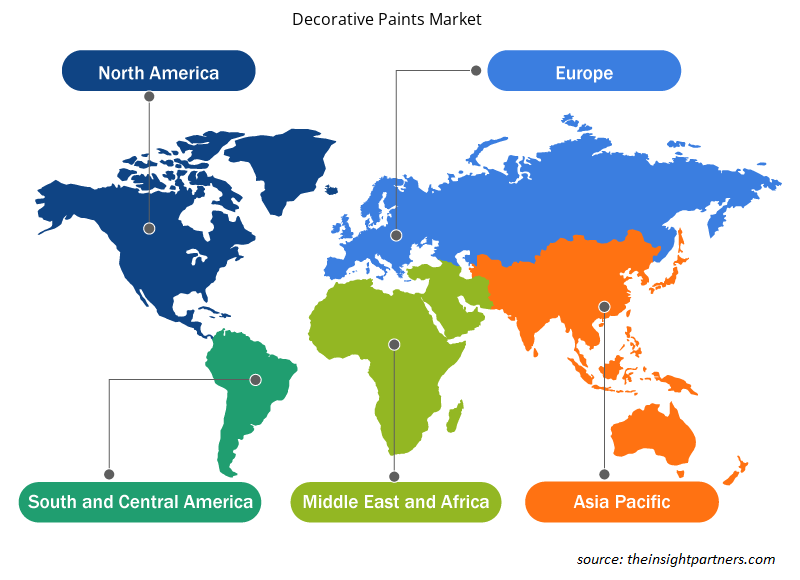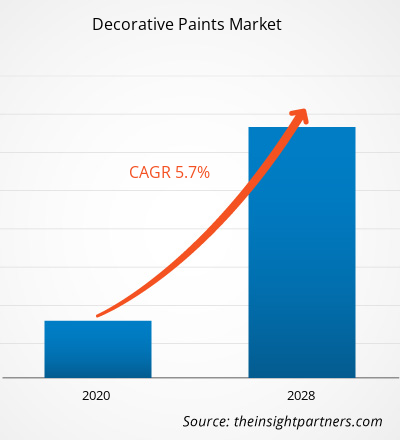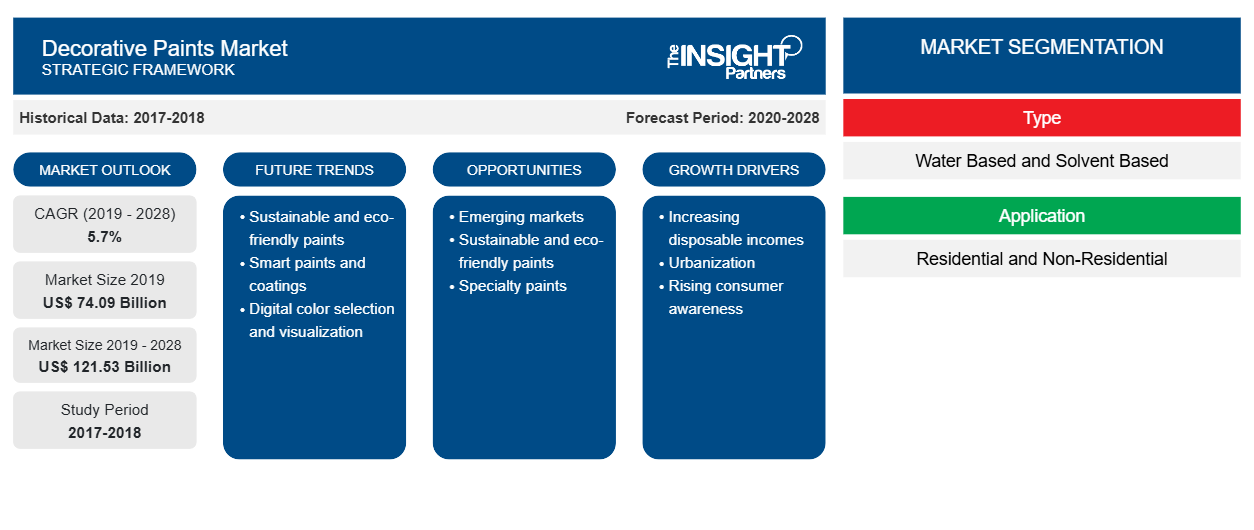Il mercato delle vernici decorative è stato valutato a 74.091,54 milioni di dollari nel 2019 e si prevede che raggiungerà i 121.531,91 milioni di dollari entro il 2028; si prevede una crescita a un CAGR del 5,7% dal 2020 al 2028.
Le pitture decorative sono definite come pitture acriliche che aiutano a conferire design estetici e texture distintive in applicazioni interne ed esterne. La domanda di pitture decorative è in aumento a causa dei mutevoli modelli di vita dei consumatori e della crescente attenzione all'aspetto di case, uffici, complessi e altri spazi simili. Con la crescita dell'industria delle pitture, l'applicazione di pitture decorative nel settore infrastrutturale e architettonico è stata riconosciuta in quanto aiutano ad abbellire sia gli spazi esterni che quelli interni di un edificio. Tali pitture sono incorporate con finitura opaca insieme a finitura a guscio d'uovo, lucida o satinata e molto altro, il che le aiuta a fornire pezzi artistici unici. Inoltre, le pitture decorative sono note per le loro varie caratteristiche funzionali come assorbimento e riflessione della luce, isolamento termico e bassa emissione di composti organici volatili.
Si prevede che il mercato delle vernici decorative in Europa crescerà al ritmo più elevato durante il periodo di previsione. L'aumento del numero di progetti infrastrutturali, dovuto ai crescenti investimenti e alla ripresa economica, spinge la domanda di vernici decorative nella regione. Le pratiche di costruzione e la progettazione della pavimentazione richiedono principalmente materiali di alta qualità per soddisfare vari standard infrastrutturali. La crescente domanda di migliori standard di vita da parte di una nuova popolazione della classe media ha un effetto positivo sull'adozione di vernici decorative. Le vernici architettoniche consumate e prodotte nell'Europa occidentale sono quasi esclusivamente prodotti di fascia media o premium, poiché l'interesse dei consumatori per la decorazione della casa rimane elevato. Inoltre, i prodotti economici sono stati tradizionalmente popolari in Russia e nell'Europa centro-orientale. Il crescente consumo di vernice è storicamente correlato al crescente standard di vita. Attualmente, il mercato delle vernici decorative nell'Europa occidentale è relativamente maturo e si prevede che le vendite aumenteranno moderatamente. Inoltre, nell'Europa centro-orientale e nei paesi della CSI, l'attuale consumo di vernice decorativa pro capite è notevolmente inferiore rispetto all'Europa occidentale.
Personalizza questo report in base alle tue esigenze
Riceverai la personalizzazione gratuita di qualsiasi report, comprese parti di questo report, o analisi a livello nazionale, pacchetto dati Excel, oltre a usufruire di grandi offerte e sconti per start-up e università
-
Scopri le principali tendenze di mercato in questo rapporto.Questo campione GRATUITO includerà analisi di dati che spaziano dalle tendenze di mercato alle stime e alle previsioni.
Impatto della pandemia di COVID-19 sul mercato delle vernici decorative
L'attuale pandemia di COVID-19 ha alterato drasticamente lo stato dell'industria chimica e ostacolato la crescita del mercato delle vernici decorative. La crisi ha distorto l'efficienza operativa e interrotto le catene del valore a causa della chiusura improvvisa dei confini nazionali e internazionali, creando perdite di fatturato e danni. Inoltre, le vernici decorative sono utilizzate principalmente nelle applicazioni edili; pertanto, l'interruzione di tali attività a causa della pandemia ha ridotto la domanda di vernici decorative. Ad esempio, le attività di costruzione in tutta l'India hanno effettivamente subito un duro colpo a causa del blocco e delle restrizioni dovute alla crisi del COVID-19. Secondo l'ultimo aggiornamento del Ministero delle statistiche in India, i progetti di costruzione sono in ritardo rispetto alla tabella di marcia di una media di 3,5 anni. Inoltre, il costo di quasi 1.682 progetti infrastrutturali in corso è aumentato di 54 trilioni di dollari. L'interruzione delle attività di costruzione in vari paesi e le limitazioni alla fornitura di materie prime dovute alla catena del valore dirompente stanno inoltre frenando la crescita del mercato. Tuttavia, poiché le economie stanno pianificando di rilanciare le loro attività, si prevede che la domanda di vernici decorative aumenterà a livello globale nei prossimi mesi. Sebbene l'attenzione sulla produzione just in time sia un altro fattore preoccupante che ostacola la crescita del mercato. Con la crescente attenzione sullo sviluppo dell'economia in tempi post-pandemia, si prevede che la domanda di vernici decorative farà enormi balzi grazie all'espansione delle basi di applicazione. Inoltre, le misure positive intraprese dal governo insieme alle generazioni distribuite e all'incorporazione di tecnologie avanzate sono un altro fattore che dovrebbe rafforzare la crescita del mercato durante il periodo di previsione.
Approfondimenti di mercato
Crescita del settore delle costruzioni
L'edilizia è uno dei settori industriali più dinamici, significativamente correlati all'evoluzione di società migliori in tutto il mondo. Con l'aumento del reddito disponibile insieme al cambiamento nello stile di vita e al cambiamento nella demografia lavorativa, è aumentata la necessità di migliori spazi residenziali e commerciali e strutture architettoniche, il che sta guidando la crescita del settore edile. La crescita del mercato globale delle vernici decorative è guidata dall'aumento della spesa pubblica nel settore edile insieme alla ripresa del mercato del lavoro, alla forte crescita del credito e alle misure positive intraprese dal governo. La crescita nel settore residenziale e commerciale insieme alle nuove attività di ristrutturazione promuove la domanda di vernici decorative.
Tipo Informazioni
In base al tipo, il mercato delle vernici decorative è diviso in a base d'acqua e a base di solvente. Il segmento a base d'acqua ha rappresentato una quota di mercato maggiore nel 2019. Le vernici decorative a base d'acqua contengono l'80% di acqua come solvente. Queste vernici sono utilizzate principalmente per le loro proprietà, come le basse emissioni di COV. La domanda di vernici decorative a base d'acqua è in aumento a causa della crescente spesa per attività di costruzione e restauro. Pigmenti, tensioattivi, resine sintetiche e additivi sono le materie prime utilizzate principalmente nel processo di produzione di vernici decorative a base d'acqua. Una vernice decorativa a base d'acqua si asciuga molto rapidamente, è facile da pulire e non ha un odore pungente come le vernici a olio. Le vernici sono disponibili in due tipi: lattice e acrilico. Entrambe queste vernici sono utilizzate per dipingere spazi, case e strutture. La vernice acrilica offre una migliore durata, resilienza e aderenza. La vernice al lattice fornisce fondamentalmente una maggiore copertura rispetto alla vernice acrilica; è più ecologica e anche meno costosa. Le vernici decorative a base d'acqua garantiscono durata e tenuta del colore e sono versatili, il che significa che possono essere utilizzate su una varietà di materiali, come mattoni, cemento, legno, rivestimenti in alluminio e rivestimenti in vinile.
Approfondimenti sulle applicazioni
In base all'applicazione, il mercato delle pitture decorative è diviso in residenziale e non residenziale. Il segmento residenziale ha rappresentato una quota di mercato maggiore nel 2019 e si prevede che il segmento non residenziale registrerà un CAGR più elevato nel mercato durante il periodo di previsione. L'applicazione residenziale include fondamentalmente la verniciatura degli interni e degli esterni di case o residenze. Le pitture decorative sono utilizzate per scopi residenziali in quanto conferiscono un fascino estetico alle pareti e ad altre superfici e contribuiscono a migliorarne l'aspetto. Il settore residenziale è in crescita poiché vi è un aumento delle costruzioni residenziali in America meridionale e centrale. L'aumento del reddito pro capite ha portato a un aumento delle proprietà immobiliari, il che sta spingendo la domanda di pitture decorative per scopi residenziali. La rapida urbanizzazione in questa regione guiderà anche la crescita del mercato delle pitture decorative nei prossimi anni.
Alcuni attori che operano nel mercato delle vernici decorative sono Nippon Paint, Akzo Nobel NV, BASF SE, Dow Inc., Axalta Coating Systems, Asian Paints, PPG Industries Inc., RPM International Inc, Kansai e The Sherwin-Williams. Le aziende chiave adottano fusioni e acquisizioni e strategie di ricerca e sviluppo per espandere la base clienti e ottenere una quota significativa nel mercato globale, il che consente loro anche di mantenere il loro marchio a livello globale.
Approfondimenti regionali sul mercato delle vernici decorative
Le tendenze regionali e i fattori che influenzano il Decorative Paints Market durante il periodo di previsione sono stati ampiamente spiegati dagli analisti di Insight Partners. Questa sezione discute anche i segmenti e la geografia del Decorative Paints Market in Nord America, Europa, Asia Pacifico, Medio Oriente e Africa e Sud e Centro America.

- Ottieni i dati specifici regionali per il mercato delle vernici decorative
Ambito del rapporto sul mercato delle pitture decorative
| Attributo del report | Dettagli |
|---|---|
| Dimensioni del mercato nel 2019 | 74,09 miliardi di dollari USA |
| Dimensioni del mercato entro il 2028 | 121,53 miliardi di dollari USA |
| CAGR globale (2019 - 2028) | 5,7% |
| Dati storici | 2017-2018 |
| Periodo di previsione | 2020-2028 |
| Segmenti coperti |
Per tipo
|
| Regioni e Paesi coperti |
America del Nord
|
| Leader di mercato e profili aziendali chiave |
|
Densità degli attori del mercato delle vernici decorative: comprendere il suo impatto sulle dinamiche aziendali
Il mercato delle pitture decorative sta crescendo rapidamente, spinto dalla crescente domanda degli utenti finali dovuta a fattori quali l'evoluzione delle preferenze dei consumatori, i progressi tecnologici e una maggiore consapevolezza dei vantaggi del prodotto. Con l'aumento della domanda, le aziende stanno ampliando le loro offerte, innovando per soddisfare le esigenze dei consumatori e capitalizzando sulle tendenze emergenti, il che alimenta ulteriormente la crescita del mercato.
La densità degli operatori di mercato si riferisce alla distribuzione di aziende o società che operano in un particolare mercato o settore. Indica quanti concorrenti (operatori di mercato) sono presenti in un dato spazio di mercato in relazione alle sue dimensioni o al valore di mercato totale.
Le principali aziende che operano nel mercato delle vernici decorative sono:
- Vernice giapponese
- Akzo Nobel NV
- BASF SE
- Società quotata in borsa Dow Inc.
- Sistemi di verniciatura Axalta
Disclaimer : le aziende elencate sopra non sono classificate secondo un ordine particolare.

- Ottieni una panoramica dei principali attori del mercato delle vernici decorative
Segnala i riflettori
- Tendenze progressive del settore nel mercato delle vernici decorative per aiutare gli operatori a sviluppare strategie efficaci a lungo termine.
- Strategie di crescita aziendale adottate dai mercati sviluppati e in via di sviluppo.
- Analisi quantitativa del mercato delle pitture decorative dal 2018 al 2028
- Stima della domanda globale di vernici decorative
- Analisi PEST per illustrare l'efficacia degli acquirenti e dei fornitori che operano nel settore.
- Sviluppi recenti per comprendere lo scenario competitivo del mercato.
- Tendenze e prospettive del mercato, nonché fattori che determinano e frenano la crescita del mercato delle vernici decorative.
- Assistenza nel processo decisionale evidenziando le strategie di mercato che sostengono l'interesse commerciale, portando alla crescita del mercato.
- La dimensione del mercato delle vernici decorative in vari nodi
- Panoramica dettagliata e segmentazione del mercato, nonché dinamiche del settore delle vernici decorative
- Dimensioni del mercato delle vernici decorative in varie regioni con promettenti opportunità di crescita
Mercato delle pitture decorative, per tipo
- A base d'acqua
- A base di solvente
Mercato delle pitture decorative, per applicazione
- Residenziale
- Non residenziale
Profili aziendali
- Vernice giapponese
- Akzo Nobel NV
- BASF SE
- Società quotata in borsa Dow Inc.
- Sistemi di verniciatura Axalta
- Pitture asiatiche
- Società controllata da PPG Industries Inc.
- RPM Internazionale Inc.
- Il Kansai
- La Sherwin-Williams
- Analisi storica (2 anni), anno base, previsione (7 anni) con CAGR
- Analisi PEST e SWOT
- Valore/volume delle dimensioni del mercato - Globale, Regionale, Nazionale
- Industria e panorama competitivo
- Set di dati Excel
Report recenti
Rapporti correlati
Testimonianze
Motivo dell'acquisto
- Processo decisionale informato
- Comprensione delle dinamiche di mercato
- Analisi competitiva
- Analisi dei clienti
- Previsioni di mercato
- Mitigazione del rischio
- Pianificazione strategica
- Giustificazione degli investimenti
- Identificazione dei mercati emergenti
- Miglioramento delle strategie di marketing
- Aumento dell'efficienza operativa
- Allineamento alle tendenze normative























 Ottieni un campione gratuito per - Mercato delle pitture decorative
Ottieni un campione gratuito per - Mercato delle pitture decorative